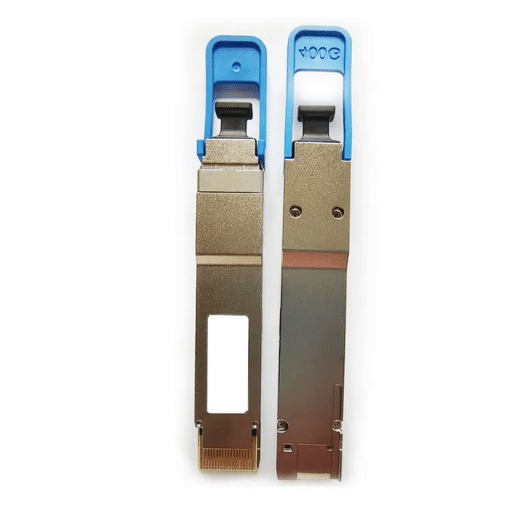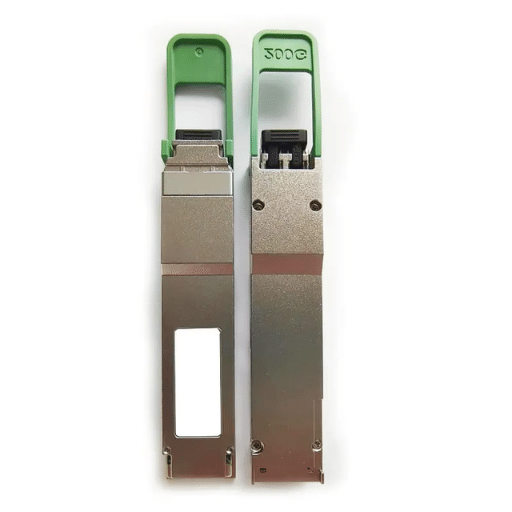The QSFP56 Optical Transceiver is a high-performance, compact, cost-effective solution for interconnecting 200G Ethernet and data center applications. Leveraging the power of four channels of up to 50Gbps each, the 200G QSFP56 sets a new benchmark in data transmission efficiency, effectively quadrupling the capacity of its predecessor. It offers unparalleled data density and lower power consumption, making it an ideal choice for data centers seeking to optimize rack space and reduce operational expenses.

The QSFP56 (Quad Small Form-Factor Pluggable 56) Optical Transceiver is a module designed to support high-speed communication networks. The ’56’ in its name signifies the data rate per channel, showcasing its ability to transmit data at 56 Gigabits per second. Its functionality converts electrical signals into optical signals, allowing for efficient, high-speed data transmission over fiber optic cables. The versatility of the 200G QSFP56 lies in its capability to support different network standards, including 200GBASE Ethernet and 2x InfiniBand HDR. With this flexibility, networks can be upgraded or extended without a complete system overhaul, providing a future-proof solution that keeps pace with advancing technology.

The 200G QSFP56 Optical Transceivers employ cutting-edge optical technology to ensure high-speed and efficient data transmission. They are equipped with laser arrays that generate light signals transmitted over fiber optic cables. These transceivers incorporate sophisticated mechanisms that minimize signal loss, ensuring reliable and seamless data transmission.
The Optical Transmission process in 200G QSFP56 Optical Transceivers is a fascinating interplay of optics and electronics. It begins with converting electrical signals into light pulses via a laser or light-emitting diode (LED). These light pulses are transmitted through fiber optic cables at incredible speeds, reaching up to 56 gigabits per second per channel. The receiving end of the transmission line houses a photodetector, which converts these light signals back into electrical ones. This entire process happens in a matter of nanoseconds, thereby offering lightning-fast data transmission. The QSFP56 transceivers ensure optimal signal integrity throughout the transmission path, thanks to advanced techniques like Forward Error Correction (FEC) and high-performance amplifiers. With such state-of-the-art technology, the 200G QSFP56 Optical Transceivers are the epitome of high-speed, reliable, and efficient data transmission in modern networking applications.
The 850nm wavelength plays a significant role in the operation of 200G QSFP56 Optical Transceivers, specifically in short-range multimode fiber applications. This wavelength is optimal for data transmission distances of up to 100 meters on multimode fiber. It is ideal for data center interconnects and intra-building links where short-reach, high-bandwidth connections are required. The 850nm wavelength also allows the utilization of cost-effective Vertical-Cavity Surface-Emitting Lasers (VCSELs) in QSFP56 transceivers. VCSELs offer advantages such as low power consumption, high speed, compact size, and reliability, thus further enhancing the efficiency and cost-effectiveness of 200G QSFP56 transceivers. Therefore, choosing the 850nm wavelength is a strategic move that improves the performance of these transceivers while keeping operational costs in check.
The choice between single-mode and multimode fiber in 200G QSFP56 Optical Transceivers depends on the specific application and distance requirements. With its thin core, single-mode fiber allows only one pathway (mode) for light propagation. This minimizes signal loss and distortion, making it ideal for long-distance, high-speed transmission. On the other hand, multimode fiber has a larger core, which allows multiple light modes to propagate, making it suitable for short-distance, high-bandwidth applications. While single-mode fibers can span tens of kilometers without the need for signal regeneration, their deployment is generally more expensive due to the cost of the required precise lasers. Using less costly VCSELs, Multimode fibers offer a more cost-effective solution for short-distance applications, such as those familiar with data centers. However, it’s important to note that the performance of both fiber types can be maximized using 200G QSFP56 Optical Transceivers, providing optimal transmission speed, reliability, and efficiency.

The 200G QSFP56 Transceiver Modules are several types designed to meet different network requirements. One of the prominent types is the 200GBASE-SR4 QSFP56 Transceiver Module.
The 200GBASE-SR4 QSFP56 Transceiver Modules are designed for high-speed, short-range data transmission. These modules use 8 lanes of multimode fiber at a rate of 25Gbps per lane, over a wavelength of 850nm, to achieve 200Gbps. They are ideal for data center connectivity, particularly for applications requiring high bandwidth over short distances.
QSFP-DD (Quad Small Form-Factor Pluggable Double Density) is a new module and cage/connector system similar to the current QSFP but with an additional row of contacts providing an eight-lane electrical interface. It is designed to keep pace with the ever-increasing demands of network traffic. The QSFP-DD’s higher density and scalability make it more compatible with the 200G QSFP56 Transceiver Modules. This allows for greater port density and overall system cost reductions, making 200G QSFP56 modules a more efficient and cost-effective solution for data transmission.
Compared to other transceiver modules, the 200G QSFP56 stands out due to its high-density design and superior performance. For instance, compared to QSFP28 modules, the 200G QSFP56 offers twice the bandwidth yet maintains the same form factor, allowing for a seamless upgrade. The QSFP56 also compares favorably with CFP2 modules, offering a higher port density and lower power consumption while maintaining the same data transmission rate, making it a more cost-effective and efficient solution for high-speed data transmission needs.

The 200G QSFP56 transceiver modules support an electrical interface that employs a high-speed differential signaling technique. This advanced method minimizes electromagnetic interference, ensuring the data’s integrity over the interface. Moreover, the QSFP56 modules can interact seamlessly with existing QSFP connectors, providing a straightforward path for system upgrades.
The electrical interface of 200G QSFP56 transceivers is an integral component that transfers the converted electrical signals from the internal circuitry to the network. It employs a sophisticated high-speed differential signaling technique, allowing high-speed data to be transmitted over relatively long distances. This technique minimizes electromagnetic interference, thereby ensuring the data integrity during transmission. Notably, the QSFP56 electrical interface is compatible with the existing QSFP connectors, offering a seamless and cost-effective upgrade path for systems seeking higher bandwidth capabilities. Ultimately, the advanced electrical interface of the 200G QSFP56 transceivers ensures that data transmission is efficient, reliable, and interference-free.
200G QSFP56 transceivers have demonstrated exceptional compatibility and performance within data center environments. Their high-speed, high-density characteristics align with the increasing demands for bandwidth and efficiency in data centers globally. Whether it’s cloud computing, virtualization, or high-performance computing (HPC), the versatility of QSFP56 transceivers can accommodate these applications effectively. In cloud computing, these modules support the high-speed, high-volume data transfer between servers and storage infrastructure. For virtualization, they provide the much-needed bandwidth to handle multiple virtual machines and applications without throttling network performance. In HPC scenarios, the 200G QSFP56 transceivers enable quick transfer of large datasets, which is crucial for timely data analysis and decision-making. Furthermore, the QSFP56 transceivers are compatible with many network equipment, including switches, routers, and servers, making them a versatile, efficient choice for modern data center applications.
When evaluating the 200G QSFP56 transceivers against other Ethernet standards, it’s clear that these modules provide unique advantages. For instance, compared to the 40GbE QSFP+ and 100GbE QSFP28 standards, the 200G QSFP56 modules offer significantly higher data rates, providing increased bandwidth for data-intensive applications. Despite the higher data rates, these modules maintain a similar physical footprint, enabling more efficient use of port space within network devices. In contrast to the 400GbE QSFP-DD standard, the 200G QSFP56 transceivers present a more cost-effective solution, offering high data rates at a lower cost per bit. Moreover, due to their backward compatibility with QSFP+ and QSFP28 modules, 200G QSFP56 transceivers provide a flexible upgrade path, allowing network operators to scale their infrastructure to meet increasing data demands without requiring substantial hardware modifications. Ultimately, the 200G QSFP56 transceivers stand as a compelling choice in the Ethernet transceiver market due to their high performance, cost-effectiveness, and compatibility blend.

The 200G QSFP56 transceivers offer numerous advantages, making them ideal for modern networking environments. With superior bandwidth performance of up to 200Gbps, they meet the high data demands of today’s networks. These transceivers maintain the same form factor as previous generation modules (QSFP+ and QSFP28), enabling easy system upgrades without extensive hardware modifications. Additionally, the QSFP56 transceivers are highly energy-efficient, consuming less power per transmitted bit than other types. This reduces operational costs and is especially crucial in power-intensive data center environments. Moreover, they are compatible with a wide range of network equipment, ensuring versatility and seamless integration into existing network infrastructure. Experience enhanced networking performance with our 200G QSFP56 transceivers!
The 200G QSFP56 transceivers find their use cases in various network environments that require high data rates, such as data centers, high-performance computing (HPC), and telecommunication networks. In data centers, these transceivers connect switches and servers, supporting the high-speed, high-volume data transfer. In HPC, they enable quick transfer of large datasets, aiding in timely data analysis. In telecommunication networks, these modules can facilitate long-distance data transmission at high speeds, enhancing the overall efficiency and performance of the network.
Despite the advantages above, the 200G QSFP56 transceivers have certain limitations that must be considered. Due to the high data rate, these transceivers may generate more heat, potentially impacting system stability and lifespan if not adequately managed. Moreover, while these modules are designed to be compatible with existing network equipment, some older hardware may not support the high data rates of the QSFP56 modules, necessitating hardware upgrades in those cases.
When deploying 200G QSFP56 transceivers, several factors need consideration. Network operators should ensure their existing hardware can support the 200G data rate. Moreover, adequate cooling measures should be in place due to the increased heat generation. Finally, while QSFP56 modules offer a cost-effective upgrade path, the initial investment can be significant, especially for large-scale deployments. Therefore, a comprehensive cost-benefit analysis should be conducted before deployment to ensure that the upgrade to QSFP56 modules aligns with the organization’s budget and network requirements.
In conclusion, the 200G QSFP56 optical transceivers stand as a powerful solution for meeting the ever-increasing demands for data bandwidth and efficiency in various network environments. From data centers to HPC, these modules deliver superior performance, versatility, and cost-effectiveness, despite limitations like potential heat generation and compatibility issues with older hardware. Given their high data rate, compatibility with various network equipment and efficient use of port space, these transceivers offer a compelling upgrade path for many network operators. However, careful consideration, including a comprehensive cost-benefit analysis and evaluation of existing hardware and cooling measures, is essential before large-scale deployment. With proper planning and execution, deploying 200G QSFP56 optical transceivers can significantly enhance network performance and efficiency.
A: A 200G QSFP56 optical transceiver is a high-speed optical module used in data centers for optical transmission.
A: A 200G QSFP56 optical transceiver has a QSFP56 form factor, an LC connector for the visual interface, and a 38-pin connector for the electrical interface.
A: QSFP56 stands for Quad Small Form-Factor Pluggable 56.
A: A 200G QSFP56 optical transceiver has a higher data rate than a 100G QSFP28 optical transceiver.
A: A 200G QSFP56 SR4 optical transceiver can transmit data up to 100 meters using multimode fiber.
A: A 200G QSFP56 optical transceiver complies with IEEE 802.3bs standards.
A: The main difference is the size and electrical interface. QSFP56 has a 38-pin electrical interface, while QSFP-DD has a 76-pin electrical interface.
A: No, a 200G QSFP56 optical transceiver is incompatible with a QSFP-DD transceiver.
A: A 200G QSFP56 FR4 optical transceiver can transmit data up to 2 kilometers using single-mode fiber.
A: A 200G QSFP56 optical transceiver supports multimode and single-mode fiber.
Recommend Reading: 200G QSFP56 for sale